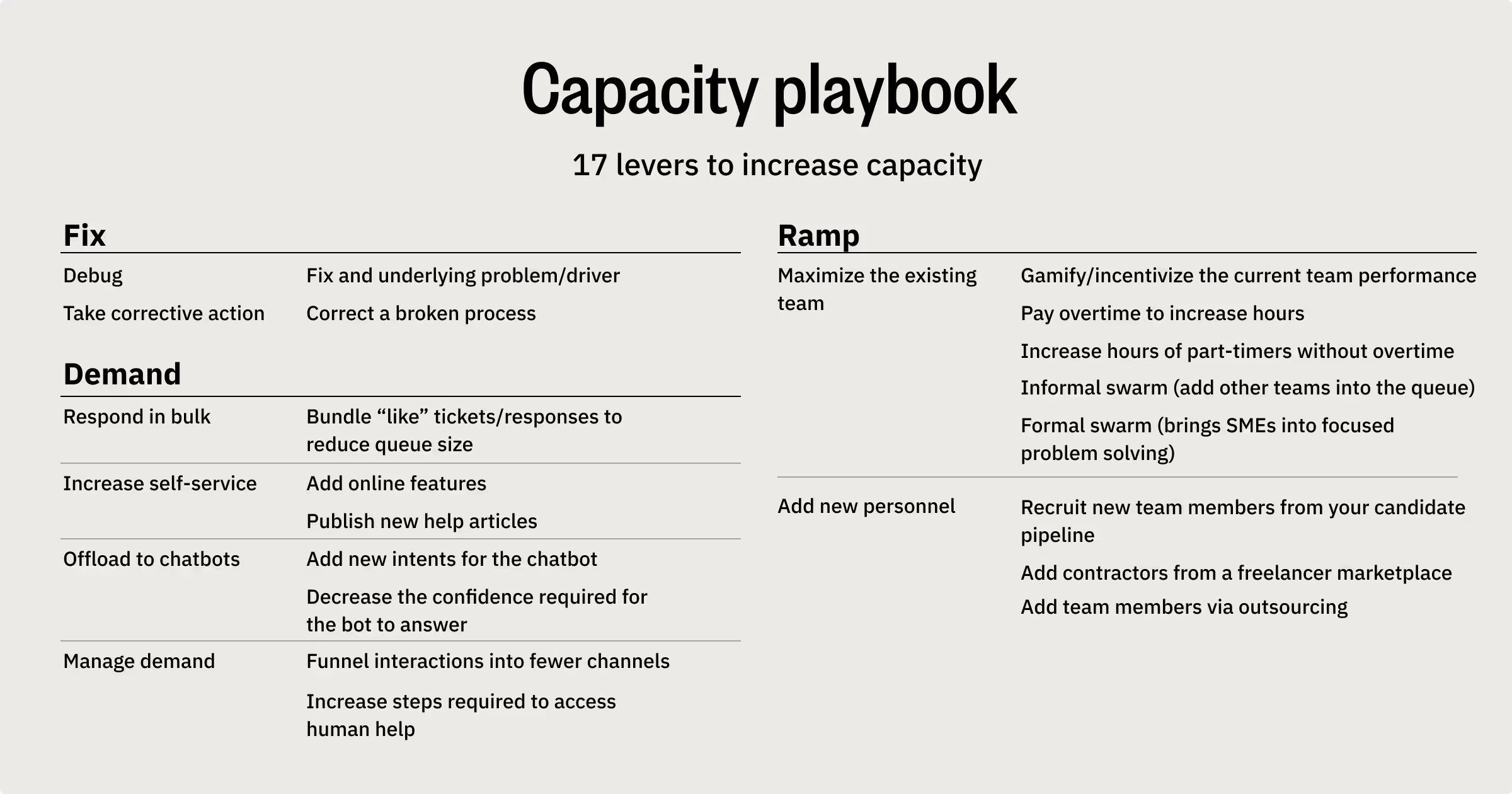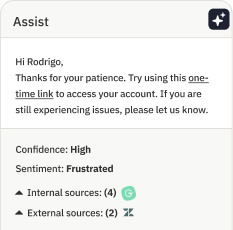Building an elastic workforce: Planning, systems, and execution

If you’ve ever been responsible for customer service, you’re familiar with the challenge of frontline staffing. You need to recruit and hire people with the right personalities to represent your brand; assimilate them into company culture; train them on your systems and products; and provide them with the right processes, tools, and equipment. Plus, you need the right number of agents to handle incoming customer demands — which, by the way, can vary day-by-day, or even hour-by-hour.
If you’ve been in the role for more than a minute, you’ve managed through times when your company was not prepared. You’ve read the negative reviews, seen your brand get beat up on social media, listened to feedback from frustrated customers, explained yourself to stakeholders, vented to confidants, and pitched a recovery plan to your executive peers. Even if you successfully navigated through these periods, you earned some scars and lost sleep over it.
After an experience like that, you realized that it’s not only about having the answers but also about having enough people to deliver them. As head of customer service, you don’t want to disappoint customers or stress out team members and therefore resist being put in that position again. “I need more staff,” is the instinctive response. But adding headcount is expensive and requires a strong business case.
This is why workforce management (WFM) is so important: it’s solving for something visceral, social, highly visible, and on the frontlines where emotions flare. Getting WFM wrong hits us where it hurts.
Getting WFM right starts with planning
If you could see into the future, you could avoid the unnecessary expense of being overstaffed when demand for customer service is low. You could also avoid the long wait times, dissatisfied customers, and burned-out employees from being understaffed when demand is high. But, of course, none of us have a crystal ball. Instead, planning boils down to making educated guesses about the future.
Humanity has been making educated guesses about the future since the first person got caught out in the rain. Today, cutting-edge forecasting science uses “deep learning and machine learning algorithms to find patterns and make predictions about future events,” with statistical techniques such as “logistics and linear regression models, neural networks and decision trees.”
While it’s still mostly about probabilities and pattern matching, the state of predictive analytics has evolved beyond what mere mortals armed with spreadsheets can easily accomplish. Rather than building your own forecasting model, it makes sense to acquire a best-in-class WFM system if your company can afford it.
Getting WFM right requires the right system
The power of a WFM system is that it can process huge amounts of complex information about the past, combine that with knowledge of your company’s goals and capabilities, then make projections about the future and present that data in ways that create practical benefit for your company. Using modern WFM tools, you can minim ize the pains of understaffing and overstaffing — while carefully managing expenses — by planning ahead.
But, in essence, your WFM system is a model produced by advanced software. And the famous quip by statistician George Box is that “All models are wrong, some are useful.” What this means is that your WFM system’s value lies in its effectiveness at improving business outcomes.

Don’t neglect these practical criteria when selecting a WFM system for your company:
- Statistical prowess. Make sure the system has real predictive analytics capabilities. It should be more than a beautiful repackaging of an underlying spreadsheet.
- Easy to implement. If the system is cumbersome to implement, it will be cumbersome to change. Therefore, it will become misaligned over time and become a burden. Also, look for pre-built integrations with your favorite CRM or CCaaS.
- Ease to use. The user interface, onboarding process, and training materials will drive adoption, without which you’ll lose your ROI.
- Designed for today’s organizations. The system should be compatible with your structure, which may include multiple business process outsourcers (BPOs) alongside your internal team. It should also factor in the real risks and assumptions that you face. If you have to significantly adjust your business processes to adapt to the software, it was likely built by brilliant academics who haven’t been in the trenches.
- Actionable. When you run the plan, it should be glaringly obvious what staffing and scheduling moves you need to make. If you have to export data to a spreadsheet to figure that out, you’re likely just getting a forecast without the full WFM solution.
- Measures success. Your chosen package should make it easy to measure the success of your WFM program as well as your team’s ability to meet the recommended plans. You also shouldn’t have to parse it out for different teams or BPOs.
Getting WFM right requires an ability to execute
Benjamin Franklin said, “By failing to prepare, you are preparing to fail.” There are myriad reasons why companies fail to execute their workforce plans. Here are several examples:
- Externalities. 2022 was one of the hardest years on record to recruit talent, ending with 10 million unfilled U.S. jobs. Other recent externalities were the Covid-19 pandemic, The Great Resignation, Quiet Quitting, a recession, the Silicon Valley Bank failure, and more. Black swans are becoming the norm; you must be able to adjust.
- Short-term focus. Planning requires managers to look ahead, but that can be hard to do if you are putting out fires, mired in a project, focusing on the current quarter, etc.
- Second-guessing. Empowering managers is a best practice, but not when it comes to judging whether the WFM algorithm is accurate. If you are ignoring your WFM system and going with your gut, you might have trust issues.
- Hiring practices. If you have a hiring bureaucracy and/or overly strict selection criteria, lack resources to vet and interview, won’t allow remote or part-time employees, or don’t use BPOs, good luck making rapid staffing adjustments.
- Single threading. If you are sourcing from a single talent pool and operating from one location, don’t be surprised when a black swan event shuts down your operation. Consider diversifying by geography and other dimensions.
- Control issues. In some cases, organizational charts have the head of customer service at the top and an army beneath. If that’s your business, it’s tempting to embrace that power. But if you are not soliciting and heeding the advice of experts, you might miss out on great ideas.
- Systems limitations. You probably receive 50 emails per day about “revolutionary” new software tools. Most of us don’t have the time, resources, or budget to try them out. Still, if you tune out technical advances, you will miss out.
The list above highlights that planning is meaningless if you aren’t prepared to act on it. The Society for Human Resources Management (SHRM) puts it this way: “Organizations need an approach that moves workforce planning from the domain of ‘futurists,’ where only a few people live, to the domain of operational effectiveness, where management is accustomed to spending its time and energy.”
Practical advice for executing your workforce plan
Let’s assume you have a killer WFM system in place; now, you are turning your focus to execution. This practical advice will help you manage your WFM program with greater success.
- Get connected. Make sure your WFM system is integrated with the CRM, CCaaS, and other systems of record.
- Get buy-in. In addition to executive buy-in, ensure your training and performance management systems drive adoption by cross-functional line leaders and frontline staff.
- Be consistent. Run plans on a cadence — with mandatory participation and without fail. Balance time spent on short-term issues with longer time horizons. This ensures you don’t just work in the business, but also on the business.
- Input gold. We know better than to input garbage into a data system. Invest the time required to input up-to-date, realistic assumptions about your business and its drivers.
- Dollarize outputs. Be sure any plan can be expressed not only in headcount, staffing hours, or work units but also as financial outcomes. If you can’t translate your plan into CFO-speak, you’ll find it more difficult to pull levers.
- Run scenarios. Don’t stop with the most probable forecast and baseline assumptions. Develop plans for both upside and downside demand scenarios, as well as alternative assumptions about externalities and your business levers. This will open the range of possible outcomes and force you to think about, and plan for, various contingencies.
- Build an elastic workforce. To immunize your company against rising and falling demand and unexpected shocks to the system, build a flexible, agile, scalable, and resilient workforce.
The advice above largely focuses on the WFM planning process itself. However, the final recommendation — to build an elastic workforce — is all about execution.
Blueprint for workforce elasticity: the capacity playbook
A famous proverb says, “The best time to plant a tree was 30 years ago. The second best time is today.” Similarly, when customer service tickets are piling up, and blood pressures are rising accordingly, it’s tempting to complain that we should have seen this coming and increased staff a month ago. True. But the second best course of action is to adjust in real time.
It is inevitable that your WFM plans will not perfectly predict future demand. So, it’s imperative that your workforce can adjust to the ever-changing flow of tickets. To make this possible, you should develop a capacity playbook, which specifies the levers your company can pull to make these adjustments. When you are falling behind, consider this model for your capacity playbook:

Important precautions when adding new personnel
A famous quote, attributed to Abraham Lincoln, highlights the importance of being prepared: “Give me six hours to chop down a tree and I will spend the first four sharpening the axe.” So, when you need to add capacity and your playbook points to new headcount, you should already have a plan. Here are some precautions for building your talent pipeline.
- Recruiting new internal team members can be problematic.
- Costly and slow. The average new hire takes 42 days and costs companies over $4,129.
- Hard to source talent. “If every unemployed person in the country found a job, we would still have 4 million open jobs.”
- Hard to retain talent. Up to 40% of U.S. workers are considering quitting their jobs. Beyond the 47 million people who resigned last year, there is also the emerging trend of quiet quitting, where disengaged employees do the absolute minimum work required to avoid getting fired.
- Hard to ramp. Companies are uncomfortable reducing headcount when demand wanes, leading to overstaffing. Conversely, leaders are slow to hire internally, leading to understaffing.
- Adding contractors from a freelancer marketplace is not a silver bullet
- Administrative burden. While you can access headcount this way, you still have to interview, onboard, equip, train, schedule, measure quality, manage, pay, and file taxes for each and every contractor.
- Individually managed. While outsourcing can bring you headcount at scale, freelance sites require you to manage each and every contractor individually.
- Outsourcing may be the best answer if you are prepared for it
- Sourcing challenges. There are thousands of outsourcing companies. Infrequent outsourcers may not know how to identify and vet the best-fit partners. Even experienced outsourcers have blind spots.
- Contracting challenges. Large outsourcers can be strict with terms and conditions and may require lengthy terms.
- Management challenges. Leaders must transition from managing individual contributors to managing an outsourcing company, a different skill.
Key recommendations for an elastic workforce
A smartly designed outsourcing strategy provides by far the most elasticity of the options listed above. Outsourcing allows you to access global talent pools, achieve up to 70% cost savings versus insourcing, scale up or down with relative ease and speed, reduce your administrative burden, and improve business outcomes. But to achieve these benefits, you should consider several key recommendations.
- Use more than one BPO. If you have enough demand, it is rarely advisable to single source. There are numerous reasons why a great business relationship can periodically produce poor results, so you should not put all your eggs in one basket. Plus, BPOs can back each other up in case of downtime. And you increase the ability to scale when more than one BPO is available to pick up demand.
- Use more than one geography. Diversifying your locations creates additional resilience. Sometimes one country has more available talent than another, so you increase your access to talent pools this way. You also reduce the risk of downtime due to adverse weather, unrest, or other crises.
- Use more than one staffing model. Tap into BPOs that can employ center-based, remote, gig, and part-time team members, which increases the ability to scale when needed.
- Create competition. BPOs should be cross-trained and win more share of your business by outperforming their peers. This fosters creative problem-solving and increases the probability of accessing headcount on short notice when needed. A lightweight version of this is called the challenger-champion model, while a fully competitive model with multiple BPOs can be called an “arena.”
- Tap an outsourcing marketplace. Outsourcing marketplaces provide the world’s largest and most elastic talent pools, increase competitive dynamics, and decrease the challenges of sourcing, contracting, and managing your BPO partners. When you need quality capacity quickly, this should be your go-to option.





